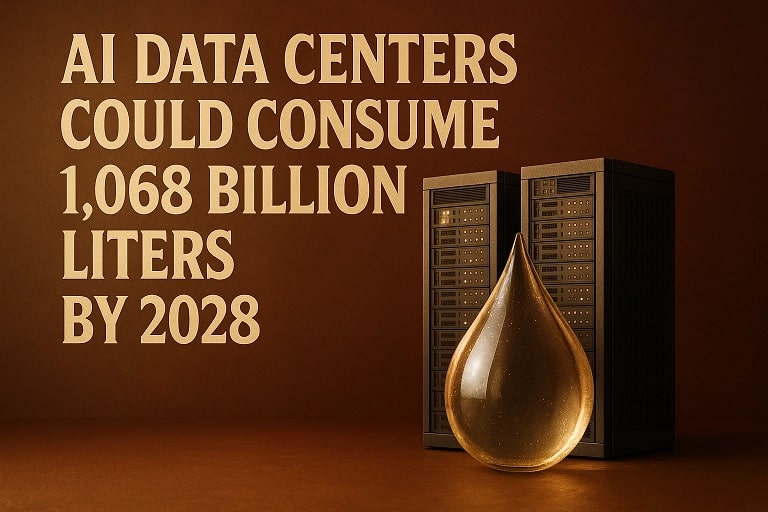AI Data Centers Could Consume 1,068 Billion Liters by 2028: A Growing Water Crisis
A recent Morgan Stanley report warns that AI data centers could drive global water consumption for cooling and electricity generation to approximately 1,068 billion liters annually by 2028, an 11-fold increase from 2024 estimates. This surge, encompassing direct cooling (scope 1), electricity production (scope 2), and semiconductor manufacturing (scope 3), highlights the hidden environmental cost of AI’s rapid expansion. As data centers proliferate in water-stressed regions, the impact is localized and severe, exacerbating scarcity in areas already facing drought and declining quality. This article examines the drivers behind this projection, historical trends, future implications, and impacts, with a focus on India’s vulnerability and Tamil Nadu’s role in sustainable tech solutions.
Why This Projection Matters
AI’s computational demands require massive energy and cooling, with data centers projected to consume 12% of U.S. electricity by 2028. The 1,068 billion liters—equivalent to the annual water use of several small countries—underscores the tension between innovation and resource sustainability. In India, where 70% of the population relies on agriculture and water stress affects 600 million people, this could strain resources amid the country’s AI ambitions. Tamil Nadu, a tech and manufacturing hub, faces risks from data center growth but also opportunities in water-efficient cooling tech, aligning with IMC 2025’s rural tech transformation.
Latest Developments Driving the Projection
The Morgan Stanley report, released in September 2025, projects AI data centers’ water use could range from 637 billion to 1,485 billion liters by 2028, depending on efficiency and energy mix. Key developments include:
- Scope 1 (Direct Cooling): Data centers evaporate 1-9 liters per kWh via evaporative systems, with hyperscalers like Google using 23 billion liters in 2023. U.S. centers alone may double direct use to 64 billion liters by 2028.
- Scope 2 (Electricity Generation): Thermoelectric plants withdraw 7.6 liters per kWh evaporated, accounting for the largest share. With AI demanding 300 TWh annually by 2028, indirect use could reach 800 billion liters in the U.S.
- Scope 3 (Semiconductor Manufacturing): Chip fabs consume 19 million liters daily per facility for ultrapure water in cleaning and etching, with AI’s chip demand amplifying this.
- Regional Stress: Over half of global data hubs are in high-water-stress areas; in India, Chennai and Bengaluru centers strain local supplies.
- Tech Responses: Companies like AWS use treated sewage for 24 centers, aiming for water positivity by 2030, while Microsoft and Google pledge replenishment.
Tamil Nadu’s Context
Tamil Nadu, hosting data centers in Chennai, faces acute water stress (e.g., 2024 Chennai crisis). The state’s IT sector, contributing 10% to GDP, could adopt efficient cooling, with Coimbatore startups innovating recycled water tech for IMC 2025.
Historical Context of AI’s Water Footprint
AI’s environmental impact has grown with its computational scale:
- 2010s: Early data centers used 2-3 liters per kWh; Google’s 2019 report revealed 15 billion liters annually.
- 2020: COVID accelerated cloud use; GPT-3 training evaporated 700,000 liters.
- 2023: Global data centers consumed 560 billion liters; U.S. indirect use hit 800 billion liters.
- 2024: AI prompts like ChatGPT used 519 ml each; India’s data centers withdrew 4.2-6.6 billion m³ projected for 2027.
- 2025: Morgan Stanley’s 1,068 billion liters forecast highlights 11x growth, driven by AI’s 300 TWh demand.
Tamil Nadu’s 2024 water crisis, exacerbated by IT growth, mirrors global trends, prompting state initiatives for recycled water.
Future Scopes and Projections
By 2028, AI data centers could consume 1,068 billion liters, varying by efficiency (637-1,485 billion liters). Projections include:
- Global Scale: U.S. direct use doubles to 64 billion liters; indirect hits 1,200 billion liters by 2030.
- India’s Burden: With 100+ data centers, consumption could reach 50 billion liters, stressing Tamil Nadu’s reservoirs.
- Efficiency Gains: Air cooling and recycled water could cut use 50%; sodium-ion batteries reduce indirect scope 2.
- Policy Shifts: EU mandates water reporting by 2026; India’s PLI scheme incentivizes green data centers.
Long-Term Strategic Outlook
By 2035, AI could demand 10% of global water; Tamil Nadu aims for 100% recycled cooling in new centers. Challenges: 50% of hubs in stressed areas; solutions like AWS’s sewage use scale, but enforcement lags.
Impacts on the Indian Economy and Stakeholders
The projection threatens water security but spurs innovation, with Tamil Nadu at the crossroads.
Sector-Wise Impacts
Technology and Data Centers
- Impact: Chennai’s centers evaporate 10 billion liters annually; stress leads to outages.
- Economic Contribution: ₹5,000 crore in efficiency tech, with Tamil Nadu at 30%.
- Business Opportunities: Coimbatore startups develop air-cooling systems.
Agriculture
- Impact: Water diversion affects Tamil Nadu’s 50 lakh farmers; competes with irrigation.
- Economic Contribution: ₹2,000 crore losses mitigated by recycled tech.
- Business Opportunities: IoT for water monitoring in Thanjavur.
Energy and Environment
- Impact: Scope 2 ties to thermal plants; 300 TWh demand strains grids.
- Economic Contribution: ₹3,000 crore in green hydrogen alternatives.
- Business Opportunities: Chennai firms innovate low-water semiconductors.
Impact Snapshot
| Scope | Water Use (2028) | Tamil Nadu Impact |
|---|---|---|
| Scope 1 (Cooling) | 200 billion liters | Chennai center evaporation |
| Scope 2 (Electricity) | 700 billion liters | Grid strain, thermal plant competition |
| Scope 3 (Semiconductors) | 168 billion liters | Coimbatore chip fab water needs |
| Total (Base Case) | 1,068 billion liters | ₹5,000 crore in efficiency investments |
Frequently Asked Questions (FAQs)
What drives the 1,068 billion liters projection?
Cooling (scope 1), electricity (scope 2), and semiconductors (scope 3), with 11x growth from AI’s energy demands.
How does this affect India?
Strains water-stressed regions; Tamil Nadu’s data centers compete with agriculture.
What mitigation strategies exist?
Recycled water, air cooling; companies aim for positivity by 2030.
What are the scenarios?
Base: 1,068 billion; low: 637 billion; high: 1,485 billion by 2028.
How can Tamil Nadu respond?
Invest in low-water tech; startups develop solutions for IMC 2025.












